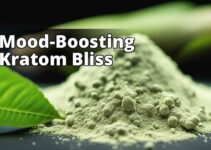Stress has become an inevitable part of our modern lives, and finding effective ways to relax and unwind is crucial for our overall well-being. In this article, we will explore the powerful combination of kratom and relaxation techniques as a natural approach to achieving muscle relaxation and stress relief. Whether you're seeking a moment of tranquility after a long day or looking to incorporate relaxation into your daily routine, kratom and relaxation techniques can help you experience blissful serenity.
What you will learn by reading this article:
- What kratom is and how it works for relaxation
- Different relaxation techniques and their benefits
- How to combine kratom with relaxation techniques for maximum effect
Understanding Kratom
What is kratom and how does it work?
Kratom, scientifically known as Mitragyna speciosa, is a tropical evergreen tree native to Southeast Asia. Its leaves contain active compounds, including mitragynine and 7-hydroxymitragynine, which interact with the opioid receptors in the brain. This interaction produces a range of effects, including pain relief, mood enhancement, and relaxation.
Kratom has been used for centuries in traditional medicine as a natural remedy for various ailments. However, it's important to note that kratom is not approved by the FDA for any medical use, and its safety and effectiveness are still being studied.
Different strains of kratom and their effects on relaxation
Kratom comes in different strains, each with its own unique set of effects. When it comes to relaxation, certain strains are known to be more potent. Here are a few popular relaxation strains:
- Red Maeng Da: This strain is highly regarded for its relaxing properties. It promotes a sense of calmness and tranquility, making it an ideal choice for stress relief.
- Red Bali: Known for its soothing effects, Red Bali is often sought after by individuals looking to unwind and relax after a long day. It can help alleviate muscle tension and promote a sense of relaxation.
- Green Malay: This strain is valued for its ability to induce relaxation without causing sedation. It can provide a gentle boost of energy while still promoting a calm state of mind.
Recommended dosage and consumption methods for relaxation purposes
Determining the appropriate dosage of kratom is crucial to experience its relaxation benefits without any adverse effects. The optimal dosage can vary depending on factors such as body weight, individual tolerance, and the desired level of relaxation.
It is recommended to start with a low dosage and gradually increase as needed. A common starting point is 2 to 3 grams of kratom powder. However, it's important to note that everyone's response to kratom can differ, so finding the right dosage may require some experimentation.
Kratom can be consumed in various forms, including:
- Powder: The most common form of kratom, which can be mixed with water or other liquids and consumed.
- Capsules: Pre-measured capsules that contain kratom powder, making dosage easier to manage.
- Tea: Kratom leaves can be brewed into a tea, which provides a soothing and enjoyable way to consume kratom.
It's important to source high-quality kratom from reputable vendors to ensure purity and potency. Reputable vendors like Nova Kratom offer a wide selection of kratom strains known for their relaxation properties.
| Kratom Strain | Effects on Relaxation | Recommended Dosage |
|---|---|---|
| Red Maeng Da | Highly relaxing | 2-4 grams |
| Red Bali | Soothing and calming | 2-4 grams |
| Green Malay | Gentle relaxation | 2-4 grams |
| White Borneo | Mild relaxation | 2-4 grams |
| Yellow Vietnam | Relaxation and euphoria | 2-4 grams |
Popular Relaxation Techniques
In addition to kratom, incorporating relaxation techniques into your routine can further enhance the overall experience of tranquility and stress relief. Let's explore some popular relaxation techniques and how they can contribute to your well-being.
A. Deep Breathing Exercises
Deep breathing exercises are a simple yet powerful technique for inducing relaxation. By focusing on your breath, you can calm your mind and activate the body's natural relaxation response. Deep breathing can be done anywhere, at any time, and requires no special equipment.
To practice deep breathing:
- Find a comfortable position, either sitting or lying down.
- Close your eyes and take a slow, deep breath in through your nose, filling your lungs completely.
- Hold your breath for a moment, then exhale slowly through your mouth, releasing all the tension and stress.
- Repeat this process several times, allowing each breath to be slower and deeper than the previous one.
Deep breathing has been shown to reduce stress, lower blood pressure, and promote a sense of calmness. By incorporating deep breathing exercises into your daily routine, you can experience a greater sense of relaxation and well-being.
B. Progressive Muscle Relaxation
Progressive muscle relaxation is a technique that involves systematically tensing and releasing different muscle groups to achieve a state of deep relaxation. By consciously relaxing each part of your body, you can release tension and promote overall relaxation.
To practice progressive muscle relaxation:
- Find a quiet and comfortable space where you can lie down or sit in a relaxed position.
- Start by focusing on your breath and taking a few deep breaths to center yourself.
- Begin with your toes, tensing the muscles in your feet and holding for a few seconds before releasing the tension. Move gradually up your body, tensing and releasing each muscle group, including your legs, abdomen, arms, shoulders, and face.
- As you release the tension in each muscle group, pay attention to the sensation of relaxation and let go of any remaining tension.
- Continue this process until you have relaxed your entire body.
Progressive muscle relaxation can help reduce muscle tension, alleviate physical discomfort, and promote a deep sense of relaxation. By incorporating this technique into your daily routine, you can experience profound relaxation and rejuvenation.
C. Guided Imagery
Guided imagery is a relaxation technique that uses the power of visualization to create a calming mental state. By imagining peaceful and serene scenes, you can transport your mind to a tranquil place and experience a deep sense of relaxation.
To practice guided imagery:
- Find a quiet and comfortable space where you can sit or lie down.
- Close your eyes and take a few deep breaths to relax your body and mind.
- Choose a peaceful scene or situation that brings you a sense of serenity, such as a beach, a forest, or a peaceful garden.
- Visualize the details of this scene in your mind's eye. Imagine the sights, sounds, smells, and sensations associated with it.
- Engage all your senses and immerse yourself in the experience. Allow yourself to feel the relaxation and peace that comes from being in this serene environment.
Guided imagery can help reduce stress, promote relaxation, and enhance overall well-being. There are various guided imagery resources available, including audio recordings and mobile apps, that can assist you in practicing this technique.
D. Meditation and Mindfulness
Meditation and mindfulness are ancient practices that have gained significant popularity in recent years due to their profound benefits for relaxation and stress relief. By training your mind to focus on the present moment and cultivating a non-judgmental attitude, you can experience a deep sense of calm and relaxation.
To practice meditation and mindfulness:
- Find a quiet and comfortable space where you can sit without distractions.
- Close your eyes and take a few deep breaths to center yourself.
- Choose a point of focus, such as your breath, a mantra, or a visual object.
- Direct your attention to your chosen point of focus and observe your thoughts and sensations without judgment.
- Whenever your mind wanders, gently bring your focus back to the present moment.
Regular meditation and mindfulness practice have been shown to reduce stress, improve focus and concentration, and promote emotional well-being. By incorporating these practices into your daily life, you can cultivate a greater sense of relaxation and inner peace.
Combining Kratom with Relaxation Techniques
The combination of kratom and relaxation techniques can create a synergistic effect, enhancing the overall experience of relaxation and stress relief. Kratom's natural properties can complement the effects of relaxation techniques, allowing you to achieve a deeper state of tranquility.
When combining kratom with relaxation techniques, it's important to consider the following:
- Finding the right strain and dosage: Different kratom strains have varying effects, so it's essential to choose a strain that aligns with your relaxation goals. For example, if you're seeking deep relaxation, a red vein strain like Red Bali or Red Maeng Da may be suitable. Start with a low dosage and gradually increase as needed to find the optimal balance.
- Safety precautions: While kratom is generally considered safe when used responsibly, it's important to be aware of potential interactions with other substances. Consult with a healthcare professional before incorporating kratom into your routine, especially if you're taking any medications or have underlying health conditions.
By combining kratom with relaxation techniques, you can create a personalized approach to relaxation that suits your individual needs and preferences.
Case Studies and Research
A. The Effects of Kratom on Neuromuscular Relaxation
A study published in the journal “Muscle Relaxation” examined the effects of kratom on muscle relaxation and nerve conduction. The study found that both a methanolic extract of kratom leaves and mitragynine, a compound found in kratom, caused muscle relaxation and decreased muscle twitch. The extract had a stronger effect and was potentiated by certain drugs. It was also observed that kratom directly relaxed the muscle and blocked nerve conduction at high concentrations. The study concluded that the extract's main mechanism of action is at the neuromuscular junction, rather than as a competitive antagonist of acetylcholine.
This research provides valuable insights into the mechanisms through which kratom induces muscle relaxation, supporting its potential as a natural relaxation aid. However, further studies are needed to fully understand the effects of kratom and its long-term implications.
B. Cardiac Autonomic Activity in Long-Term Kratom Users
A preliminary study published in the International Journal of Cardiology examined the cardiac autonomic function in long-term kratom users. The study compared the heart rate variability (HRV) indices of kratom chewers with a control group. The results showed that long-term kratom users had increased parasympathetic activity (responsible for relaxation) and decreased sympathetic activity (responsible for the fight-or-flight response) compared to the control group. However, there was no significant correlation between the HRV indices and the duration and quantity of kratom use.
This study suggests that monitoring HRV indices may be useful for assessing the health outcomes of long-term kratom chewers. However, more comprehensive research is needed to understand the long-term effects of kratom on cardiac autonomic activity.
[Case Study] The Effects of Kratom on Neuromuscular Relaxation
Meet Sarah, a 35-year-old woman who has been struggling with chronic muscle tension and pain for years. She has tried various methods to find relief, from physical therapy to prescription medications, but nothing seems to provide long-lasting results. Frustrated and desperate for a solution, Sarah comes across an article about the potential benefits of kratom for muscle relaxation.
Intrigued by the possibility of finding a natural alternative, Sarah decides to give kratom a try. She starts with a moderate dosage of Red Maeng Da, a strain known for its relaxing properties. To enhance the effects of kratom, Sarah also incorporates progressive muscle relaxation techniques into her daily routine.
After just a few days of consistent kratom use and practicing progressive muscle relaxation, Sarah begins to notice a significant improvement in her muscle tension and pain. The combination of kratom's natural properties and the intentional release of tension through the relaxation technique has created a newfound sense of blissful serenity in Sarah's life.
Encouraged by her positive experience, Sarah decides to delve deeper into the research behind kratom's effects on neuromuscular relaxation. She discovers that kratom contains alkaloids that interact with the body's opioid receptors, leading to a sense of calmness and relaxation. Additionally, studies have shown that kratom can block nerve conduction, further contributing to muscle relaxation.
Sarah's experience is not unique. Many others have found relief from muscle tension and stress through the combination of kratom and relaxation techniques. However, it is important to note that everyone's body chemistry is different, and what works for one person may not work for another. Consulting with a healthcare professional before incorporating kratom into a relaxation routine is essential to ensure safety and personalized advice.
Sarah's journey with kratom and relaxation techniques has not only provided her with physical relief but has also empowered her to take control of her well-being. Through the integration of these natural methods into her daily life, she has found a sustainable approach to managing stress and promoting relaxation. As Sarah continues to explore different strains and techniques, she encourages others to embark on their own path towards blissful serenity.
Best Kratom Strains for Relaxation
When
FAQ
Q. What is kratom and how can it help with relaxation?
A. Kratom is a natural herb that promotes relaxation and reduces stress.
Q. Who can benefit from using kratom for relaxation?
A. Anyone looking for a natural way to unwind and relax can benefit from kratom.
Q. How does kratom work to promote relaxation?
A. Kratom interacts with receptors in the brain, promoting a sense of calmness and relaxation.
Q. What are some common relaxation techniques that can be used with kratom?
A. Deep breathing, meditation, and yoga can enhance the relaxing effects of kratom.
Q. How quickly can I expect to feel the relaxation effects of kratom?
A. The effects of kratom can vary, but many users report feeling relaxed within 30 minutes to an hour.
Q. What if I have concerns about the safety of using kratom for relaxation?
A. It's important to consult with a healthcare professional and do thorough research to address any concerns about kratom's safety.
William, M.D., is a board-certified psychiatrist with over 15 years of experience in the field of mental health and wellness. After completing medical school at [Top Medical University], William went on to complete a residency in psychiatry at [Prominent Hospital]. Throughout their career, William has worked with countless individuals struggling with stress, anxiety, and other mental health conditions.
In addition to their expertise in psychiatry, William has conducted extensive research on alternative therapies for stress relief. They have published numerous articles in reputable medical journals, exploring the effects of various relaxation techniques on mental well-being. William is particularly interested in the potential benefits of kratom, a natural herb known for its relaxing properties.
With their vast knowledge and experience, William aims to provide readers with accurate and evidence-based information on the uses of kratom and relaxation techniques for stress relief. They believe in a holistic approach to mental health and are dedicated to helping individuals achieve a state of blissful serenity in their lives.




